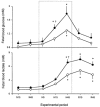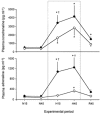Enhanced nitric oxide activity offsets peripheral vasoconstriction during acute hypoxaemia via chemoreflex and adrenomedullary actions in the sheep fetus
- PMID: 12562956
- PMCID: PMC2342630
- DOI: 10.1113/jphysiol.2002.032615
Enhanced nitric oxide activity offsets peripheral vasoconstriction during acute hypoxaemia via chemoreflex and adrenomedullary actions in the sheep fetus
Abstract
We tested the hypothesis that enhanced nitric oxide (NO) opposes fetal peripheral vasoconstrictor responses to acute hypoxaemia via actions involving the carotid chemoreflex and the adrenal medulla. The hypothesis was tested in the late gestation ovine fetus using a novel NO clamp technique, which involves fetal combined treatment with the NO synthase inhibitor, L-NAME, and the NO donor, sodium nitroprusside. In contrast to treatment with L-NAME alone, combined fetal treatment with L-NAME and nitroprusside prevents generalized vasoconstriction and pronounced hypertension, not only maintaining basal cardiovascular function, but also permitting blockade of the de novo synthesis of NO during hypoxaemia while compensating for the tonic production of the gas. Under general anaesthesia, seven sheep fetuses were surgically prepared with catheters and a femoral Transonic flow probe. Five days after surgery, fetuses were subjected to a 3 h protocol: 1 h normoxia, 1 h hypoxaemia and 1 h recovery. Fetal hypoxaemia was induced during either fetal infusion with saline or treatment with the NO clamp. During saline infusion, fetuses responded to hypoxaemia with transient bradycardia, femoral vasoconstriction and increases in plasma noradrenaline and adrenaline. During fetal treatment with the NO clamp, bradycardia persisted and there were greater peripheral vasoconstrictor and catecholaminergic responses to hypoxaemia. Further analysis showed that NO clamp treatment enhanced the chemoreflex component of the fetal cardiovascular defence to acute hypoxaemia. These data support the hypothesis that enhanced NO synthesis during acute hypoxaemia offsets fetal peripheral vasoconstrictor responses to hypoxaemia via chemoreflex and adrenomedullary actions.
Figures




Similar articles
-
Cardiovascular and endocrine responses to acute hypoxaemia during and following dexamethasone infusion in the ovine fetus.J Physiol. 2003 May 15;549(Pt 1):271-87. doi: 10.1113/jphysiol.2002.036418. Epub 2003 Mar 28. J Physiol. 2003. PMID: 12665612 Free PMC article.
-
An in vivo nitric oxide clamp to investigate the influence of nitric oxide on continuous umbilical blood flow during acute hypoxaemia in the sheep fetus.J Physiol. 2001 Dec 1;537(Pt 2):587-96. doi: 10.1111/j.1469-7793.2001.00587.x. J Physiol. 2001. PMID: 11731588 Free PMC article.
-
Fetal cardiovascular, metabolic and endocrine responses to acute hypoxaemia during and following maternal treatment with dexamethasone in sheep.J Physiol. 2005 Sep 1;567(Pt 2):673-88. doi: 10.1113/jphysiol.2005.089805. Epub 2005 Jun 23. J Physiol. 2005. PMID: 15975982 Free PMC article.
-
Chemoreflexes--physiology and clinical implications.Acta Physiol Scand. 2003 Mar;177(3):377-84. doi: 10.1046/j.1365-201X.2003.01083.x. Acta Physiol Scand. 2003. PMID: 12609009 Review.
-
Human cardiovascular adjustments to acute hypoxaemia.Clin Physiol. 1987 Oct;7(5):349-76. doi: 10.1111/j.1475-097x.1987.tb00179.x. Clin Physiol. 1987. PMID: 3311579 Review.
Cited by
-
Mechanisms of death in structurally normal stillbirths.J Perinat Med. 2019 Feb 25;47(2):222-240. doi: 10.1515/jpm-2018-0216. J Perinat Med. 2019. PMID: 30231013 Free PMC article.
-
Prenatal Hypoxia Affects Foetal Cardiovascular Regulatory Mechanisms in a Sex- and Circadian-Dependent Manner: A Review.Int J Mol Sci. 2022 Mar 7;23(5):2885. doi: 10.3390/ijms23052885. Int J Mol Sci. 2022. PMID: 35270026 Free PMC article. Review.
-
Calcitonin gene-related peptide contributes to the umbilical haemodynamic defence response to acute hypoxaemia.J Physiol. 2005 Feb 15;563(Pt 1):309-17. doi: 10.1113/jphysiol.2004.077024. Epub 2004 Dec 20. J Physiol. 2005. PMID: 15611032 Free PMC article.
-
The effects of pravastatin on the normal human placenta: Lessons from ex-vivo models.PLoS One. 2017 Feb 15;12(2):e0172174. doi: 10.1371/journal.pone.0172174. eCollection 2017. PLoS One. 2017. PMID: 28199380 Free PMC article.
-
Combined Statin and Glucocorticoid Therapy for the Safer Treatment of Preterm Birth.Hypertension. 2023 Apr;80(4):837-851. doi: 10.1161/HYPERTENSIONAHA.122.19647. Epub 2023 Feb 1. Hypertension. 2023. PMID: 36724801 Free PMC article.
References
-
- Alexander DP, Bashore RA, Britton HG, Forsling ML. Maternal and fetal arginine vasopressin in the chronically catheterised sheep. Biol Neonate. 1974;25:242–248. - PubMed
-
- Bartelds B, van Bel F, Teitel DF, Rudolph AM. Carotid, not aortic, chemoreceptors mediate the fetal cardiovascular response to acute hypoxaemia in lambs. Pediatr Res. 1993;34:51–55. - PubMed
-
- Boyle DW, Hirst K, Zerbe GO, Meschia G, Wilkening RB. Fetal hind limb oxygen consumption and blood flow during acute graded hypoxia. Pediatr Res. 1990;28:94–100. - PubMed
Publication types
MeSH terms
Substances
LinkOut - more resources
Full Text Sources

